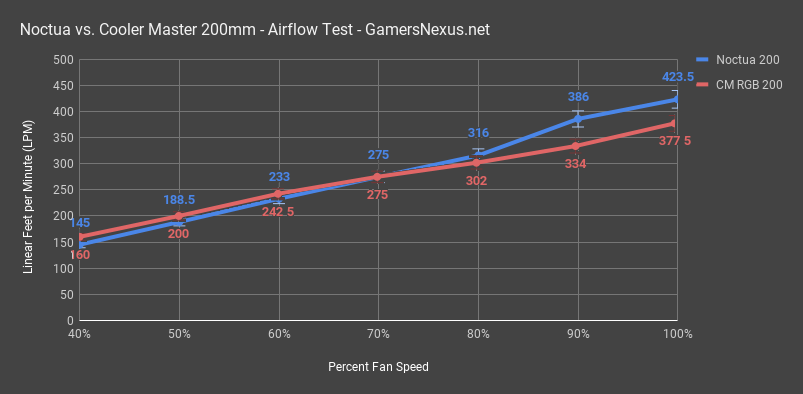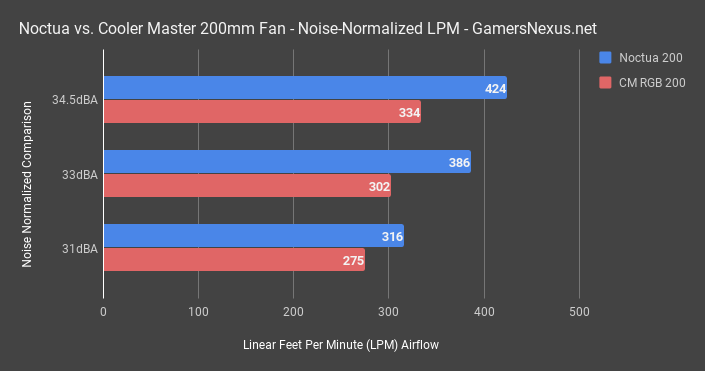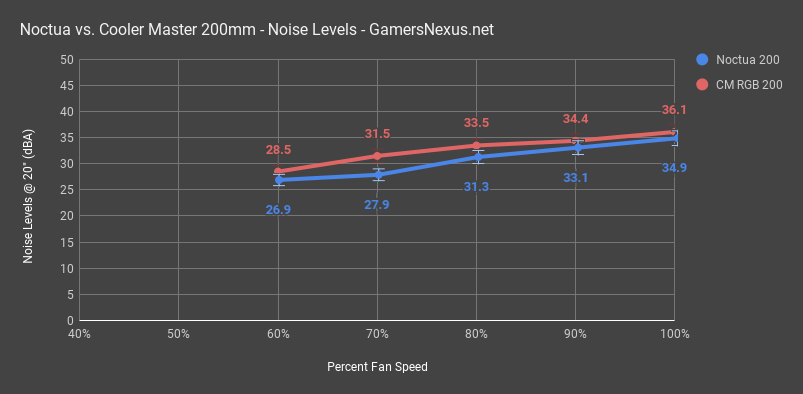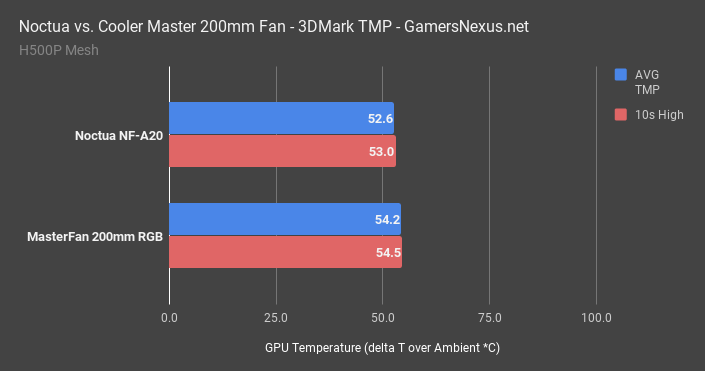The revolution of 200mm fans was a short-live one. Large fans are still around, but the brief, bombastic era of sticking a 200mm fan in every slot didn’t last long: The CM HAF X, NZXT Phantom 820, SilverStone Raven 02 (180mm), Throne & Thor, and 500R all have designs that have largely been replaced in the market. That replacement comes in the form of an obsession with the word “sleek” in marketing materials, which generally means flat, unvented paneling that would conflict with the poorer static pressure performance of large fans. That’s not to say 200mm fans are inherently good or bad, just that the industry has trended away from them.
That is, until the Cooler Master H500P, which runs 2x MasterFan MF200R units dead-center, fully garnished with RGB LEDs. We didn’t necessarily like the H500P in its stock configuration (but did fix it), but we know the case is popular, and it’s the best test bench for 200mm fans. There’s a good chance that purchasers of the NF-A20 are buying them for the H500P.
And that’s what we’re reviewing today. In this benchmark, we’re reviewing the Noctua NF-A20 200mm fans versus the Cooler Master MasterFan MF200Rs, which come stock with the H500P. The MF200R fans will almost certainly become available separately, at some point, but presently only ship with the H500P.
Why 200mm Fans Came About, and Why They Died
Before digging into the review, it’ll help to have some context: 200mm fans arrived with force, but vanished shortly thereafter. To better understand when and if 200mm fans make sense, we must review why they ever arrived, and then why they died:
Pros:
- Larger fans mean more air can move through a bigger hole, but at a lower RPM. This helps reduce the noise level while theoretically offering similar, wide-area cooling
- Larger fans also allow for wider spread, and make for excellent side-panel cooling options that can hit a bit of everything – the VRM, the GPU, and the memory can all be cooled with one fan that’s just ~160mm away (side panel)
Cons:
- Expensive to make: They need more robust bearings, and the hub and motor have to be stronger so that they can withstand the weight of the bigger blades. Going too cheap or weak in the motor, hub, and bearings can mean early death or catastrophic failure from carrying the weight of the blades (we’ve had old 200mm fan blades fracture and explode in spectacular fashion)
- Expensive to buy, as a result of the higher materials quality
- Despite being quieter as fans, the requirement of 200mm of mesh means more noise escapes the system, so it is a balance of lower fan noise vs. more mesh for system noise
- Cases moved away from cooling and focused on closed-off panels
- Non-standardized fan hole spacing means mounting compatibility concerns
The Noctua NF-A20 fan costs $30 right now, and the MasterFan isn’t available separately yet – but probably will be. The Cooler Master unit is presently only available in the H500P. Based on other MasterFan RGB prices, we’d expect the MF200R to ship somewhere within the $30-$40 range, but we’re not positive. Either way, its most likely competition is Noctua, and the two have very different looks; in fact, one clearly focuses most its energy on visuals, while the other takes the usual function-focused approach. They fill different markets, then, so the actual cooling efficacy becomes less relevant as we shift our needs away from function and toward looks. In this regard, if RGB LEDs are desired, Noctua is obviously incapable of filling the job. If function is preferred, we’ll have to see how Noctua holds up.
How We Tested
We used similar test methodology to our Noctua China-made vs. Taiwan-made fan testing, found here. We are focusing on our efforts on anemometer hotwire testing and noise testing, with PWM-to-RPM response also tested. Thermals, although present, are less significant. If we know the airflow (presented in linear feet per minute, or LPM), we can deduce everything else. Thermals introduce a lot of variables and are difficult to control for, so our focus is on airflow and noise, as they are most easily tested, and then thermals in the H500P.
That’s the other thing: When the thermals do show up, they are in the Cooler Master H500P Mesh mod that we did. Airflow is complicated, and performance may vary as you change cases (or remove the mod, for instance), but there just aren’t many common deployments for 200mm fans, and the H500P seems like the obvious one. In the very least, we can use our LPM testing to determine theoretical performance deltas in various case installations.
LPM testing is done by taking a high-end anemometer and hotwire (+/-2% accuracy), then mounting it about half-way between the outer edge of the blade and the hub, which is where the most airflow is measured. We’re mounting the fan to a Rosewill Throne side panel, which has a large, ventilated, metal mesh wiring to accommodate 200mm fans. The Throne has enough holes to accommodate both form factors we’re reviewing today, simplifying the process greatly. Mounting the fan to the panel is done with four screws, each mounted to the same torque. The side panel acts as a real-world use case: If you’re installing a 200mm fan, it’s probably up against a mesh of some kind, and will almost certainly not be used in open/free air. This means that we can test some of the static pressure capabilities of the fans, as 200mm units are traditionally challenged on that front.
The hotwire is secured on the receiving side (intake) of the mesh, while the fan is on the opposing side of the mesh wall, pushing air through the hotwire and mesh. We are testing in increments of 10% fan RPMs, scaling from 40% to 100% for LPM, sitting at 100% only for temperature, and scaling from about 60-70% to 100% for noise. Our noise floor is ~26dBA, so we have no test resolution to scale below these percentages.
Note that we have a new wind tunnel in for fan testing, but it is unfortunately too small for 200mm fans. The tunnel will be used on 120 and 140mm units, but was not used for today’s tests.
For thermals, we are following our case testing methodology:
Case Testing Methodology
We tested using our new Skylake case test bench, detailed in the table below. This particular configuration is brand new with the launch of the 570X & 270R. Results on this test platform cannot be compared to previous case benchmark results, as the platform has completely changed.
Conducting thermal tests requires careful measurement of temperatures in the surrounding environment. We control for ambient by constantly measuring temperatures with thermocouples and laser readers. We then produce charts using a Delta T(emperature) over Ambient value. This value subtracts the thermo-logged ambient value from the measured diode temperatures, producing a delta report of thermals. AIDA64 is used for logging thermals of silicon components, including the GPU diode.
All case fans are manually configured to their maximum throughput using BIOS, then we configure to an RPM closer to 1050 for a universal "quiet" testing. If a fan controller is present, we opt-in and test on multiple settings. This forces testing of case fan performance in addition to the case's air channeling and airstream design. This also ensures minimal variance when testing, as automatically controlled fan speeds can reduce reliability of benchmarking. The CPU fan is set to 1100RPM (constant) for consistency, and the CPU is overclocked to 4.4GHz with a vCore of 1.272V (constant). C-States and power saving states are disabled.
| Component | Courtesy Of | Price | |
| Video Card | MSI GTX 1080 Gaming X (OC Mode) | MSI | $640 |
| CPU | Intel i7-6700K @ 4.4GHz | GamersNexus | $300 |
| CPU Cooler | MSI Core Frozr L | MSI | TBD |
| Motherboard | MSI Z170A Gaming M7 | MSI | $180 |
| Memory | Corsair Vengeance LED 32GB 3200MHz | Corsair | $200 |
| SSD | Samsung 850 EVO 120GB | Samsung | N/A |
| PSU | Corsair RM650x | Corsair | $100 |
| Case | This is what we're testing! | - | - |
The video card is configured to run at 55% fan speed at all times.
Prior to load testing, we collect idle temperature results for ten minutes to determine the unloaded cooling performance of a case's fans and air channels. Thermal benchmarking is conducted for 1400 seconds (23 minutes), a period we've determined sufficient for achieving equilibrium. The over-time data is aggregated and will occasionally be compiled into charts, if interesting or relevant. The equilibrium performance is averaged to create the below charts.
Load testing is conducted using Prime95 LFFTs and Kombustor “FurMark” stress testing simultaneously. Testing is completely automated using in-house scripting, and executes with perfect accuracy on every run.
We recently validated our test methodology using a thermal chamber, finding our approach to be nearly perfectly accurate. Learn more here.
Noctua NF-A20 Airflow vs. CM MF200R
Our first test will show the airflow of the fans, and is measured with an anemometer recommended to GamersNexus by a couple of thermal engineers in the industry. This is the same anemometer we used in our Noctua fan comparison when looking at the China-made versus Taiwan-made fans.
Because we can’t use our new wind tunnel with fans that are this large, we have to do it the old-fashioned way: We’ll be benchmarking for linear feet per minute airflow, which can be called either FPM or LPM, depending on who’s asked, and we’re doing this as measured through a side panel. Our assumption is that most users will be placing these fans inside of cases, and probably behind a mesh of some kind.
Starting with our LPM chart now, we’re looking at a range of 40% to 100%, for which we’ll have matching RPM numbers in a moment.
The Noctua NF-A20 200 ($30 list price) fan pushed air at 423 linear feet per minute at 100% RPM, a lead over the Cooler Master MasterFan MF200R’s 378LPM. Keep in mind that these gains don’t necessarily translate directly to performance uplift in a real system, as airflow is complex, so it’s not a linear scale to convert LPM gains to temperature gains.
At the low-end of the RPM range, from 40% to 60%, Cooler Master retained a lead, but those speeds are low enough that you’re really not moving much air anyway, and not doing a whole lot of cooling: At 40%, we’re at 145-160LPM, with a breeze weak enough that there won’t be much appreciable change in component performance. The two tie at 70%, matching at 275LPM. Noise-normalized performance will help us form a comparison.
Noctua NF-A20 Normalized Noise vs. Cooler Master 200mm
These noises represent various RPMs. We can show those next. At roughly 34.5dBA, +/- 0.5dBA, the Noctua fan pushes 424LPM, where Cooler Master does 334LPM. At 33dBA, we’re running 386LPM on Noctua, and 302LPM on Cooler Master. 31dBA has us at 316LPM and 275LPM, respectively.
As for where these noise levels were chosen, here’s the noise chart.
Noctua NF-A20 Noise Levels
The rough 34.5dBA range comes as a middle-point between 100% RPM on the Noctua fan and 90% on the Cooler Master fan, which run at roughly 34.9 and 34.4 dBA, respectively.
Our testing scales down to about 26.9dBA, which is where we no longer have test resolution. The noise floor of the room is 26dBA, and we disable all system fans, so it is not possible for us to test below this noise floor, and we lose accuracy as we approach 26dBA.
The Noctua fan remains generally ahead, but has a wider acoustic performance lead at the low-end. If you recall, Cooler Master had a bit of an LPM lead at the same low-end, which would mesh with these noise findings.
Noctua NF-A20 Thermals on Cooler Master H500P
As for temperatures, Blender GPU testing often had our differences within margin of error and test resolution, with a maximum change of about 1 degree Celsius. The Blender CPU test shows about the same. Testing 3DMark Firestrike, we saw the Noctua fans were generally about 1 to 2 degrees advantaged for GPU temperatures, so not that exciting.
Conclusion: Noctua NF-A20 200mm Fan Review
Thermal differences within the H500P “Meshify” aren’t appreciable when both fans are at 100% RPM, but again, thermal testing is the most complex aspect of this: There are a lot of variables, and performance in one case may not equate performance in another case. We do know that, relative to each other, the Noctua fan pushes a higher LPM than Cooler Master at the higher RPMs, and manages to do so while retaining competitive noise levels. The Noctua NF-A20 could be run at 90% and achieve similar airflow and acoustic performance to the Cooler Master fan at 100%, which is potentially beneficial to some noise-sensitive users; that said, of course, the Cooler Master fans do have a visual advantage, and Noctua doesn’t even try to compete on that front. The fans also come stock with the H500P, making upgrades difficult to justify for purchasers of that specific case – the performance uplift is not necessarily noticeable enough, or noticeable at all (depending on noise sensitivity), and it’d be a $60 purchase for two.
Cooler Master’s MF200R fans did have a bit of axial wobble, we noticed. The large ring on the outer edge of the fan blades may contribute to this, or perhaps just weight distribution being uneven, but the fan wobbles slightly in an out-of-true manner. This causes LPM readings to have a wider range than the Noctua fan, as the LPM performance seems somewhat contingent on the axial wobble or apparent precession of the axis.
One note: The Noctua NF-A20 isn't a perfect fit in the H500P. You will either have to make some modifications or use only some of the screw holes.
We have a bigger fan round-up coming shortly, focusing on 120mm and 140mm units. Stay tuned for that. It’ll be another week or two, probably.
Editorial, Testing: Steve Burke
Thermal Testing: Patrick Lathan
Video: Andrew Coleman





